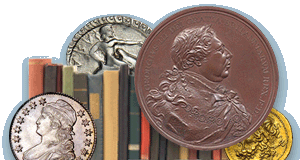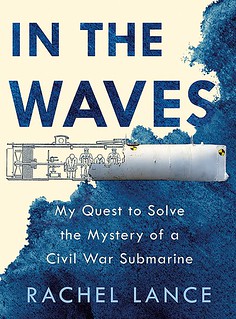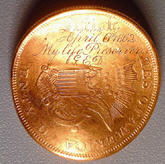
PREV ARTICLE
NEXT ARTICLE
FULL ISSUE
PREV FULL ISSUE
NEW BOOK: IN THE WAVESThanks to Dick Hanscom for passing along this Daily Mail article mentioning a new book on the Confederate submarine H. L. Hunley. The numismatic connection is the famous engraved life-saving double eagle carried by one of its doomed occupants. -Editor
Rachel Lance, a biomedical engineer and blast-injury specialist, describes her breakthrough in the forthcoming book In the Waves: My Quest to Solve The Mystery of A Civil War Submarine, due out April 7. The Hunley was the first combat submarine to sink an enemy warship, but as soon as it succeeded in its mission targeting the USS Housatonic in Charleston harbor in 1864, it mysteriously sank with all hands lost. The sub was raised from the ocean floor in 2000, adding to the mystery when it became clear that there was no damage to the hull itself. While many theories have been put forward, Lance believes that the crew was killed nearly instantly by the pressure wave from their own torpedo. She constructed a precise computer model of the ship to determine its volume, and calculated that the crew would have had a 30- to 60-minute window of warning from the time the first effects of oxygen deprivation became noticeable. Next, Lance constructed a 1/6 scale model of the Hunely and its torpedo. Unlike modern, self-propelled torpedoes, the Hunley's torpedo was a copper keg filled with black powder and attached to a 16-foot spar on the bow of the submarine, The sub had to maneuver the torpedo against the hull of an enemy ship and detonate it while still attached to the spar. Lance had to secure permission from the Bureau of Alcohol, Tobacco and Firearms to legally purchase the amount of black powder she needed for the experiment. She also had to find a willing farmer with a pond she could use for underwater testing, since officials at Duke balked at her proposal to set off explosive charges in the retention pond on campus. The experiment nearly ended in disaster when Lance and her boyfriend were driving with 20 pounds of black powder in the trunk of her car, after a serious crash on the highway right in front of them. Lance slammed on the brakes and narrowly avoided being rear-ended by the truck behind her, a collision that would have likely triggered a deadly explosion. Finally, Lance was ready to carry out the experiments on her scale model of the sub, which she dubbed the CSS Tiny. 'We set off as many charges as we could before the sun began to set on the pond. Blast after blast, we captured and saved the waveforms. I was thrilled to see that the readings looked consistent,' Lance wrote. 'And like the actual Hunley, the scale-model Tiny refused to show any damage itself, even after repeated blasts, even as it transmitted the pressures inside.' The data showed that the blast wave from the explosion passed through the ship's hull and then bounced around on the inside of the cramped submarine, with enough force to be lethal. 'My analysis showed that the amount of pressure ricocheting around inside the metal tube, combined with the quick rise time of the wave, would have put each member of the Hunley's crew at a 95 percent risk of immediate, severe pulmonary trauma,' Lance wrote. Lance believes that death would have been nearly instantaneous for the crew of the Hunley. To read the complete article, see:
To read earlier E-Sylum articles, see:
 Wayne Homren, Editor The Numismatic Bibliomania Society is a non-profit organization promoting numismatic literature. See our web site at coinbooks.org. To submit items for publication in The E-Sylum, write to the Editor at this address: whomren@gmail.com To subscribe go to: https://my.binhost.com/lists/listinfo/esylum All Rights Reserved. NBS Home Page Contact the NBS webmaster 
|

